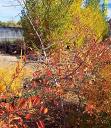Pinobete Tree Information
Images of Pinobete:






Pinobete grows in the following 7 states and provinces:
Arizona, California, Colorado, Hawaii, Maine, New Mexico, TexasInformation about Pinobete:
The Crataegus Douglasii is commonly known as the Arizona Cypress, Arizona Rough Cypress, Cedro, Cedro Blanco, Cedro De La Sierra, Pinobete, Rough-bark Cypress as well as Smooth-bark Cypress.
The accepted scientific name for Arizona cypress is Cupressus arizonica Greene. Five named varieties, considered by some authors to be separate species, are as follows : Cupressus arizonica Greene var. arizonica Arizona cypress C. a. var. montana (Wiggins) Little San Pedro Martir cypress C. a. var. glabra (Sudw.) Little smooth cypress (cedro) C. a. var. nevadensis (Abrams) Little Paiute cypress C. a. var. stephensonii (Wolf) Little Cuyamaca cypressArizona cypress has a restricted range in the southwestern United States. The typical variety is local in mountain canyons from Trans-Pecos Texas (Chisos Mountains) to southwestern New Mexico and southeastern Arizona. Arizona cypress is best developed in Mexico, from northeastern Sonora south to Durango and east to Coahuila, Zacatecas, and Tamaulipas . It is cultivated in Hawaii . Smooth cypress is local in the mountains of central Arizona . It is also cultivated in Hawaii . Piute cypress is rare and local in the Piute Mountains in the vicinity of Kern and Tulare counties, California. Cuyamaca cypress is rare and local in the Cuyamaca Mountains of San Diego County, California, and is also local in the Sierra Juarez, Baja California Norte, Mexico. San Pedro Martir cypress is local in the Sierra San Pedro Martir, Baja California Norte, Mexico .Arizona cypress is a common but scattered component of canyon riparian associations . These interior, mixed-broadleaf communities comprise a variety of typical riparian species that include Arizona sycamore (Platanus wrightii), green ash (Fraxinus pennsylvanica), cottonwoods (Populus fremontii, P. angustifolia), box elder (Acer negundo), Arizona alder (Alnus oblongifolia), bigtooth maple (Acer grandidentatum), and Arizona walnut (Juglans major) . Carmichael and others have described an Arizona cypress-shrub live oak (Quercus turbinella) association. Arizona cypress is also a frequent codominant with alligator juniper (Juniperus deppeana), pinyons (Pinus cembroides and P. edulis), and a number of oaks including silverleaf oak (Q. hypoleucoides), netleaf oak (Q. reticulata), and Arizona white oak (Q. arizonica) . In Cochise County, Arizona, Arizona cypress is co- or subdominant in oak woodlands that include Emory oak (Quercus emoryi), Mexican blue oak (Q. oblongifolia), Toumey oak (Q. toumeyi), oneseed juniper (Juniperus monosperma), and Arizona madrone (Arbutus arizonica), in addition to the aforementioned oaks and junipers . Arizona cypress is progressively more restricted to riparian habitats at lower elevations where the woodland zone grades into the shrub-dominated desert and semidesert vegetation types . Arizona cypress is also found in stands at higher elevations, mixed with other conifers including Arizona pine (Pinus ponderosa var. arizonica), Apache pine (P. engelmannii), Chihuahua pine (P. leiophylla var. chihuahuana), and Douglas-fir (Pseudotsuga menziesii) . In pure stands, Arizona cypress often forms closed canopies that preclude the occurrence of understory species over considerable portions of the stand . Shrub associates along canyon bottoms and lower slopes include skunkbush sumac (Rhus trilobata), mountain-mahogany (Cercocarpus spp.), New Mexico locust (Robinia neomexicana), cliff fendlerbush (Fendlera rupicola), indigobush (Dalea formosa), mountainbalm (Eriodictyon angustifolium), and buckthorn (Rhamnus spp.). On drier sites, understory species include sugar sumac (Rhus ovata), desert ceanothus (Ceanothus greggii), pringle manzanita (Arctostaphylos pringlei), and pointleaf manzanita (A. pungens) . Publications listing Arizona cypress or its varieties as dominant or codominant include the following: A digitized computer-compatible classification for natural and potential vegetation in the Southwest with particular reference to Arizona Plants of the Arizona chaparral Preliminary classification for the coniferous forest and woodland series of Arizona and New Mexico Biotic communities in the Sub-Mogollon region of the inland Southwest Forest and woodland vegetation monitoring, Chisos Mountains, Big Bend National Park: baseline 1978 A series vegetation classification for Region 3 Vegetation of the Santa Catalina Mountains: community types and dynamics Riparian forest and community types of Arizona and New Mexico Vegetation of the Santa Catalina Mountains, Arizona: a gradient analysis of the south slope Some of the information provided here is attributed to:Sullivan, Janet. 1993. Cupressus arizonica. In: Fire Effects Information System, [Online]. U.S. Department of Agriculture, Forest Service, Rocky Mountain Research Station, Fire Sciences Laboratory (Producer). , available at the USDA Fire Effects Information System (FEIS) website